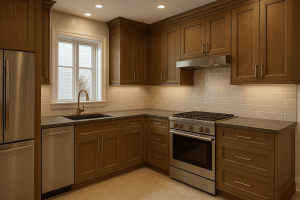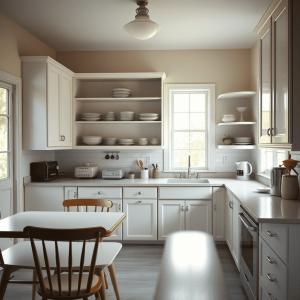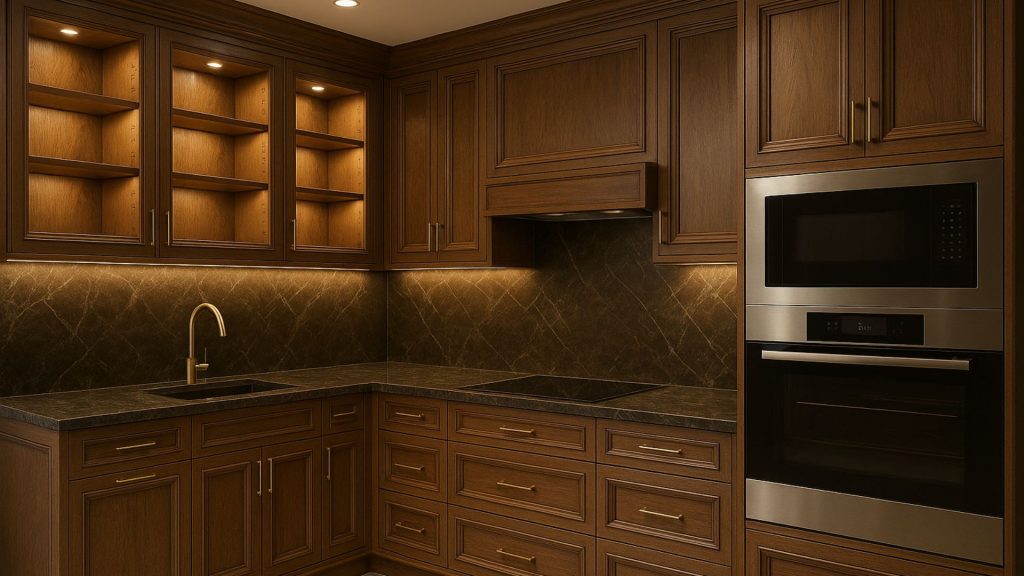A kitchen is more than just a place to cook—it\'s the heart of the home, where functionality meets design. And at the center of every well-designed kitchen is one crucial element: cabinetry. Kitchen cabinets not only define the aesthetic of your space but also determine how efficiently it functions. With an overwhelming number of options in terms of style, materials, construction types, and organizational features, choosing the right kitchen cabinetry can feel like navigating a maze.
Cabinetry Types: Custom vs. Semi-Custom vs. Stock
When you\'re planning a kitchen remodel or building from scratch, one of the first decisions you\'ll face is choosing the type of cabinetry: custom, semi-custom, or stock. Each has its own pros, cons, price points, and degrees of design flexibility. Let’s explore them in detail.
1. Stock Cabinets

Stock cabinets are pre-manufactured in standard sizes and styles, typically available for quick delivery and installation.
Pros:
- Affordability: These are the most budget-friendly options, making them ideal for cost-conscious remodels.
- Availability: Since they are mass-produced, stock cabinets can often be purchased off the shelf or with minimal lead time.
- Simple Choices: If you’re overwhelmed by too many options, stock cabinetry offers a more streamlined, ready-to-go solution.
Cons:
- Limited Sizes and Styles: You’re restricted to what the manufacturer offers—no changes to dimensions, finishes, or internal layouts.
- Fit and Function: Because they come in standard sizes, stock cabinets might not perfectly fit your kitchen, requiring fillers or modifications that reduce usable space.
- Material Quality: Typically made with lower-end materials like particleboard or laminate, though some manufacturers offer more durable options.
Best For: Budget projects, rental properties, or quick remodels where time and cost are more important than personalization.
2. Semi-Custom Cabinets
Semi-custom cabinets are pre-manufactured like stock cabinets but allow for limited customization in dimensions, finishes, and features.
Pros:
- Greater Flexibility: You can usually adjust cabinet depth, choose from a wider range of finishes, or add specific hardware or organizational features.
- Improved Quality: These often use better materials and construction methods than basic stock options.
- Balanced Pricing: More affordable than fully custom cabinets, while offering some of the personalization benefits.
Cons:
- Longer Lead Time: Because some components are made to order, you may have to wait several weeks for delivery.
- Limited Customization: You still have constraints compared to fully custom cabinets—you can tweak but not fully redesign.
Best For: Homeowners who want some personalized touches and better quality without paying top-dollar.
3. Custom Cabinets
Custom cabinets are built to your exact specifications, from dimensions to materials to features—essentially a blank canvas for your vision.
Pros:
- Unlimited Design: Any size, finish, wood type, and configuration is possible. Ideal for non-standard layouts or unique design aesthetics.
- High Quality: Custom cabinets are typically crafted by skilled carpenters or high-end manufacturers using premium materials.
- Optimized Storage: Custom cabinetry allows every inch of your kitchen to be maximized, with tailored solutions for your specific needs.
Cons:
- Cost: This is the most expensive option, both in materials and labor.
- Time-Consuming: Custom cabinets can take several weeks—or even months—to design, build, and install.
- Requires Expertise: You’ll need to work closely with a designer or cabinet maker to ensure your vision is accurately translated.
Best For: High-end kitchen remodels, unique spaces, or homeowners who want full control over every detail.
Quick Comparison Table
| Feature | Stock | Semi-Custom | Custom |
| Cost | $ | $$ | $$$$ |
| Lead Time | Short | Moderate | Long |
| Customization | Very limited | Moderate | Unlimited |
| Material Quality | Basic to mid | Mid to high | High |
| Fit & Flexibility | Least flexible | Some adjustments | Fully tailored |
Cabinetry Materials: Understanding the Core Options
When choosing kitchen cabinetry, materials are just as important as the style. Cabinets must withstand daily wear and tear, fluctuating temperatures, moisture, and spills—so selecting the right material ensures they’ll look great and last long. Here\'s a breakdown of the most commonly used cabinetry materials, including their strengths, weaknesses, and ideal use cases.
1. Solid Wood

Solid wood is the traditional and premium choice for cabinetry. It\'s often used for cabinet doors, face frames, and sometimes the entire structure.
Common Types: Maple, Oak, Cherry, Hickory, Birch, and Walnut.
Pros:
- Durability: Long-lasting and highly resistant to dents and scratches.
- Aesthetic Appeal: Rich, natural grain patterns; can be stained, painted, or finished in various ways.
- Resale Value: Solid wood cabinetry tends to appeal to buyers and increases home value.
Cons:
- Cost: One of the most expensive materials.
- Movement: Wood expands and contracts with humidity, which may cause warping over time if not sealed properly.
- Maintenance: Requires regular upkeep to maintain appearance.
Best For: High-end kitchen designs, traditional or rustic styles, and homeowners who want long-term durability and timeless beauty.
2. Plywood
Plywood is a strong, engineered wood made from multiple layers of wood veneer. It’s a popular choice for cabinet boxes.
Pros:
- Strength: High structural integrity; resists warping and sagging better than particleboard.
- Moisture Resistance: Holds up well in humid kitchen environments.
- Lighter Weight: Easier to work with than solid wood or MDF.
Cons:
- Cost: More expensive than MDF and particleboard but cheaper than solid wood.
- Inconsistent Quality: Quality varies depending on grade and manufacturer.
Best For: Cabinet boxes in both mid-range and high-end kitchens, especially where strength and longevity matter.
3. Medium-Density Fiberboard (MDF)
MDF is a composite material made from wood fibers and resin, known for its smooth surface and versatility.
Pros:
- Smooth Finish: Perfect for painted cabinets; no grain to interfere with paint or veneer application.
- Affordable: Less costly than plywood or solid wood.
- Stable: Doesn’t expand or contract like natural wood, reducing the risk of cracking in painted finishes.
Cons:
- Not Moisture-Resistant: Can swell if exposed to water unless specially treated.
- Heavy: Denser and heavier than plywood.
- Less Durable: Prone to damage if not handled with care.
Best For: Painted cabinet doors and panels, especially in contemporary or modern designs.
4. Particleboard
Made from wood chips, shavings, and resin, particleboard is the most economical cabinet material.
Pros:
- Low Cost: Ideal for budget-friendly projects.
- Lightweight: Easier to install and transport.
Cons:
- Fragile: Less sturdy than MDF or plywood; prone to sagging under heavy loads.
- Sensitive to Moisture: Swells and breaks down quickly if exposed to water.
- Short Lifespan: More susceptible to damage over time.
Best For: Budget-conscious remodels or temporary cabinetry solutions in low-traffic areas.
5. Thermofoil
Thermofoil is a vinyl layer applied to MDF using heat and pressure, creating a seamless and easy-to-clean surface.
Pros:
- Smooth & Uniform Look: Great for achieving a clean, modern appearance.
- Easy Maintenance: Wipes clean with just a damp cloth—ideal for busy kitchens.
- Affordable: Cheaper than solid wood or custom-painted finishes.
Cons:
- Heat Damage: Prone to peeling when exposed to high heat (e.g., near ovens or toasters).
- Difficult to Repair: Once damaged, the entire door or panel usually needs replacing.
- Limited Color Options: While improving, still more limited than painted wood or MDF.
Best For: Sleek, modern kitchens with a tight budget and a focus on easy maintenance.
6. Laminate

Laminate cabinets are constructed from layers of synthetic material bonded to particleboard or MDF.
Pros:
- Variety of Colors and Finishes: Includes high-gloss, matte, and even wood-look textures.
- Durability: Resists stains, moisture, and scratches reasonably well.
- Budget-Friendly: Cost-effective compared to solid wood or custom finishes.
Cons:
- Edges Can Peel: Especially in lower-quality laminates.
- Appearance: May not replicate the natural look of wood as convincingly as newer materials.
- Repair Limitations: Like Thermofoil, difficult to fix once damaged.
Best For: Modern and contemporary kitchens where style, color variety, and affordability are key.
Material Comparison at a Glance
| Material | Durability | Moisture Resistance | Cost | Ideal Use |
| Solid Wood | Excellent | Moderate | $$$$ | Doors, frames, and luxury cabinets |
| Plywood | Very Good | Good | $$$ | Cabinet boxes |
| MDF | Good | Moderate (if sealed) | $$ | Painted doors, panels |
| Particleboard | Fair | Poor | $ | Budget boxes, temporary setups |
| Thermofoil | Moderate | Good | $$ | Low-maintenance kitchens |
| Laminate | Good | Good | $$ | Modern styles, bold color choices |
Cabinet Door Styles: Shaping Your Kitchen’s Character
While the structure and material of your cabinets define their durability, it’s the door style that truly sets the tone for your kitchen’s aesthetic. Whether you\'re going for traditional elegance, clean modern lines, or a cozy farmhouse vibe, choosing the right cabinet door style makes all the difference. Let’s look at the most popular options and what they bring to the table—literally.
1. Shaker Style
Shaker doors are arguably the most popular and versatile cabinet style today. They feature a five-piece door with a recessed center panel and clean, squared edges.
Design Profile:
- Clean lines
- Minimal detailing
- Functional yet timeless
Pros:
- Versatility: Works in nearly any kitchen style—traditional, transitional, modern farmhouse, or even contemporary.
- Easy to Clean: Flat surfaces with simple grooves make maintenance easy.
- Enduring Appeal: Its classic design means it won’t go out of style anytime soon.
Cons:
- Dust Collection: The recessed panel can accumulate dust if not cleaned regularly.
- Common: Because it’s so popular, it might not feel unique to some homeowners.
Best For: Just about any kitchen, especially if you want a safe, stylish, and long-lasting design.
2. Flat-Panel (Slab) Style
Also known as slab doors, flat-panel cabinets are exactly what they sound like—a single, smooth, flat surface with no frame or panel.
Design Profile:
- Sleek and minimalist
- No ornamentation
- Often seen in high-gloss or wood veneer finishes
Pros:
- Ultra-Modern Look: Perfect for contemporary, Scandinavian, or minimalist kitchen designs.
- Easy Maintenance: No grooves or edges make for the easiest cleaning.
- Cost-Effective: Often less expensive due to simpler construction.
Cons:
- Visual Simplicity: Might look too plain or stark for some tastes.
- Fingerprints & Smudges: Especially noticeable on high-gloss finishes.
Best For: Modern and minimalist homes, urban condos, or anyone going for a streamlined, cutting-edge look.
3. Raised-Panel Style

Raised-panel doors feature a central panel that’s elevated from the surrounding frame, often with intricate detailing or beveled edges.
Design Profile:
- Traditional and decorative
- Formal or luxurious feel
- Classic woodworking detail
Pros:
- Rich Visual Texture: Adds depth and dimension to cabinetry.
- Traditional Appeal: A staple in more formal or classical kitchen designs.
- Customizable: Many design variations in terms of profiles and edge detailing.
Cons:
- Harder to Clean: All the grooves and detailing can collect dust and grime.
- Less Suited to Modern Styles: May feel too ornate or heavy in contemporary kitchens.
Best For: Traditional, classic, and formal kitchens—especially when paired with crown molding and detailed trim.
Other Notable Door Styles
Beadboard
- Features vertical planks with grooves (\"beads\") in between.
- Evokes a cottage or farmhouse charm.
- Works beautifully in coastal or rustic kitchens.
Glass-Front Doors
- Incorporates clear, frosted, or textured glass.
- Ideal for displaying fine dishware or adding openness to upper cabinets.
- Adds visual variety when mixed with solid-door cabinetry.
Inset Doors
- Doors sit flush inside the cabinet frame, rather than on top of it.
- High-end, custom look with precise craftsmanship.
- More expensive due to the precision required.
Which Style is Right for You?
Think of cabinet doors like wardrobe choices for your kitchen. If you want something cozy and relaxed, Shaker or beadboard might be your go-to. For sleek and urban, slab doors shine, for elegance and timelessness, raised panels or inset doors bring luxury.
Pro Tip: Don\'t be afraid to mix styles—Shaker on the base cabinets and glass-front on the uppers, for example, can add dimension and sophistication to your kitchen without overwhelming it.
Smart Storage Solutions: Where Function Meets Flow
No matter how stylish your kitchen is, it needs to work efficiently. A beautiful cabinet means little if it doesn’t help you store what you need in a way that’s easy to access and organized. That’s where smart storage solutions come in. Today’s cabinetry isn’t just about shelves and drawers—it’s about maximizing every inch with clever, purpose-driven designs that make your kitchen a joy to use.
Let’s break down some of the most effective built-in storage solutions that are changing the way we use our kitchens.
1. Pull-Out Drawers

What They Are: Instead of fixed shelves, pull-out drawers allow you to access items stored deep inside your lower cabinets without bending or reaching.
Why They\'re Great:
- Full Access: Everything comes to you—no more digging for pots or stray Tupperware lids.
- Custom Fit: Can be sized for spices, utensils, pans, or even waste bins.
- Ergonomic: Easier on your back and knees, especially in base cabinets.
Ideal For:
- Heavy cookware
- Small appliances
- Pantry items
2. Lazy Susans
What They Are: Rotating trays (usually round or kidney-shaped) that fit into corner cabinets to make use of otherwise hard-to-reach spaces.
Why They\'re Great:
- Corner Mastery: Makes deep, awkward corner cabinets functional.
- Organizational Gold: Great for spices, sauces, baking supplies, or small snacks.
- Space Saver: Keeps items visible and easy to reach without cluttering.
Ideal For:
- Upper and lower corner cabinets
- Frequently used items you want within arm’s reach
3. Vertical Dividers
What They Are: Tall, narrow compartments typically placed inside upper cabinets or deep drawers to store flat items vertically instead of stacking them.
Why They\'re Great:
- No More Pile-Ups: No need to lift a stack of trays or cutting boards to get to the one you need.
- Neat & Tidy: Keeps baking sheets, cutting boards, and serving trays organized and accessible.
- Customizable Widths: Can be spaced to accommodate your specific items.
Ideal For:
- Baking trays
- Cutting boards
- Platters and serving trays
4. Appliance Garages
What They Are: Small cabinet enclosures on your countertop that hide appliances like toasters, blenders, or coffee makers behind a door or tambour (rolling) cover.
Why They\'re Great:
- Clutter-Free Counters: Keeps your kitchen looking clean while keeping appliances within reach.
- Easy Access: Just open the garage and use your appliance in place—no lifting or unplugging.
- Custom Options: Can be designed with outlets inside for true plug-and-play convenience.
Ideal For:
- Coffee stations
- Breakfast prep areas
- Hiding everyday gadgets while keeping them functional
Other Smart Features Worth Considering
- Toe-Kick Drawers: Hidden in the baseboard area—great for storing flat or seldom-used items.
- Pull-Out Pantries: Tall, narrow shelves that slide out like a drawer—ideal for storing dry goods.
- Built-in Trash & Recycling Centers: Keeps waste out of sight, with compartments for sorting.
Bringing It All Together: Cabinets That Complete Your Kitchen
Kitchen cabinetry is more than just a design decision—it\'s the foundation of how your kitchen looks, functions, and feels every day. From choosing between custom, semi-custom, and stock cabinetry to selecting materials that match your needs and door styles that suit your aesthetic, every detail matters. Add in smart storage solutions like pull-out drawers, lazy Susans, and appliance garages, and you\'ve got a space that\'s as functional as it is beautiful.
But none of this happens without skilled design and expert craftsmanship.
That’s where Jerry Polich Construction LLC comes in. With years of experience and a reputation for high-quality work, we specialize in creating kitchens that aren\'t just stunning—they’re built around the way you live. Whether you\'re dreaming of a sleek modern space or a warm, inviting traditional kitchen, we help bring those ideas to life with personalized cabinetry solutions and full-service remodeling expertise.
If you\'re considering a kitchen remodeling, our team is here to guide you from concept to completion. We take the time to understand your needs, work within your budget, and deliver results that exceed expectations. From premium cabinetry installation to complete kitchen overhauls, you can count on us to handle every detail with care and precision.
What sets us apart?
- Custom-Tailored Designs: Whether you need full custom cabinetry or clever solutions with semi-custom options, we make your kitchen work smarter and look better.
- High-Quality Craftsmanship: We use only trusted materials and proven techniques to ensure your cabinetry stands the test of time.
- Stress-Free Remodeling: With clear communication, transparent pricing, and a commitment to your satisfaction, we make the remodeling process smooth from start to finish.
Remember, your dream Kitchen is just a phone call away. Don’t wait—contact us now for a free consultation and let’s start your transformation today!

